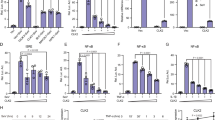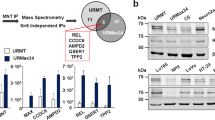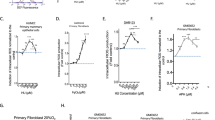Abstract
p28GANK (also known as PSMD10, p28 and gankyrin) is an ankyrin repeat anti-apoptotic oncoprotein that is commonly overexpressed in hepatocellular carcinomas and increases the degradation of p53 and Rb. NF-κB (nuclear factor-κB) is known to be sequestered in the cytoplasm by IκB (inhibitor of NF-κB) proteins 1, 2, but much less is known about the cytoplasmic retention of NF-κB by other cellular proteins. Here we show that p28GANK inhibits NF-κB activity. As a nuclear-cytoplasmic shuttling protein, p28GANK directly binds to NF-κB/RelA and exports RelA from nucleus through a chromosomal region maintenance-1 (CRM-1) dependent pathway, which results in the cytoplasmic retention of NF-κB/RelA. We demonstrate that all the ankyrin repeats of p28GANK are required for the interaction with RelA and that the N terminus of p28GANK, which contains the nuclear export sequence (NES), is responsible for suppressing NF-κB/RelA nuclear translocation. These results suggest that overexpression of p28GANK prevents the nuclear localization and inhibits the activity of NF-κB/RelA.
Similar content being viewed by others
Log in or create a free account to read this content
Gain free access to this article, as well as selected content from this journal and more on nature.com
or
References
Baldwin AS . The NF-κB and IκB proteins: new discoveries and insights. Annu Rev Immunol 1996; 14:549–583.
Ghosh S, May MJ, Kopp E . NF-κB and Rel proteins: evolutionarily conserved mediators of immune responses. Annu Rev Immunol 1998; 16:225–260.
Higashitsuji H, Itoh K, Nagao T, et al. Reduced stability of retinoblastoma protein by gankyrin, an oncogenic ankyrin-repeat protein overexpressed in hepatomas. Nat Med 2000; 6:96–99.
Hori T, Kato S, Saeki M, et al. cDNA cloning and functional analysis of p28 (Nas6p) and p40.5 (Nas7p), two novel regulatory subunits of the 26S proteasome. Gene 1998; 216:113–122.
Dawson S, Apcher S, Mee M, et al. Gankyrin is an ankyrin-repeat oncoprotein that interacts with CDK4 kinase and the S6 ATPase of the 26S proteasome. J Biol Chem 2002; 277:10893–10902.
Higashitsuji H, Itoh K, Sakurai T, et al. The oncoprotein gankyrin binds to MDM2/HDM2, enhancing ubiquitylation and degradation of p53. Cancer Cell 2005; 8:75–87.
Li HH, Fu XY, Chen Y, et al. Use of adenovirus-delivered siRNA to target oncoprotein p28GANK in hepatocellular carcinoma. Gastroenterology 2005; 128:2029–2041.
Sen R, Baltimore D . Multiple nuclear factors interact with the immunoglobulin enhancer sequences. Cell 1986; 46:705–716.
Karin M, Ben-Neriah B . Phosphorylation meets ubiquitination: the control of NF-κB activity. Annu Rev Immunol 2000; 8:621–663.
Verma IM, Stevenson JK, Schwarz EM, Van Antwerp D, Miyamoto S . Rel/NF-kappa B/I kappa B family: intimate tales of association and dissociation. Genes Dev 1995; 9:2723–2735.
Bonizzi G, Karin M . The two NF-κB activation pathways and their role in innate and adaptive immunity. Trends Immunol 2004; 25:280–288.
Barkett M, Gilmore TD . Control of apoptosis by Rel/NF-κB transcription factors. Oncogene 1999; 18:6910–6924.
Lin A, Karin M . NF-κB in cancer: a marked target. Semin Cancer Biol 2003; 13:107–114.
Beg AA, Baltimore D . An essential role for NF-κB in preventing TNF-α-induced cell death. Science 1996; 274:782–784.
Kaltschmidt B, Kaltschmidt C, Hofmann TG, Hehner SP, Droge W, Schmitz ML . The pro- or anti-apoptotic function of NF-κB is determined by the nature of the apoptotic stimulus. Eur J Biochem 2000; 267:3828–3835.
Kasibhatla S, Brunner T, Genestier L, Echeverri F, Mahboubi A, Green DR . DNA damaging agents induce expression of Fas ligand and subsequent apoptosis in T lymphocytes via the activation of NF-κB and AP-1. Mol Cell 1998; 1:543–551.
Pahl HL . Activators and target genes of Rel/NF-κB transcription factors. Oncogene 1999; 18:6853–6866.
Ryan KM, Ernst MK, Rice NR, Vousden KH . Role of NF-κB in p53-mediated programmed cell death. Nature 2000; 404:892–897.
Kudo N, matsumori N, Taoka H, et al. Leptomycin B inactivates CRM1/exportin 1 by covalent modification at a cysteine residue in the central conserved region. Pro Natl Acad Sci USA 1999; 96:9112–9117.
Baeuerle PA . IκB-NF-κB structures: at the interface of inflammation control. Cell 1998; 95:729–731.
Huxford T, Huang DB, Malek S, Ghosh G . The crystal structure of the IκB/NF-κB complex reveals mechanisms of NF-κB inactivation. Cell 1998; 95:759–770.
Huang TT, Kudo N, Yoshida M, Miyamoto S . A nuclear export signal in the N-terminal regulatory domain of IκB controls cytoplasmic localization of inactive NF-κB/IκB complexes. Proc Natl Acad Sci USA 2000; 97:1014–1019.
Huang TT, Miyamoto S . Postrepression activation of NF-κB requires the amino-terminal nuclear export signal specific to IkB. Mol Cell Biol 2001; 21:4737–4747.
Arenzana-Seisdedos F, Turpin P, Rodriguez M, Thomas D, Hay RT, Virelizier JL, Dargemont C . Nuclear localization of IκBα promotes active transport of NF-κB from the nucleus to the cytoplasm. J Cell Sci 1997; 110:369–378.
Rodriguez MS, Thompson J, Hay RT, Dargemont C . Nuclear retention of IκBα protects it from signal-induced degradation and inhibits nuclear factor κB transcriptional activation. J Biol Chem 1999; 274:9108–9115.
Vinay T, Ricardo GC, Masahito I, Verma IM . Distinct roles of IκB proteins in regulating constitutive NF-κB activity. Nat Cell Biol 2005; 7:921–923.
Higashitsuji H, Nagao T, Nonoguchi K, Fujii S, Itoh K, Fujita J . A novel protein overexpressed in hepatoma accelerates export of NF-κB from the nucleus and inhibits p53-dependent apoptosis. Cancer Cell 2002; 2:335–346.
Johnson C, Van Antwerp D, Hope TJ . An N-terminal nuclear export signal is required for the nucleocytoplasmic shuttling of IκBα. EMBO J 1999; 18:6682–6693.
Birbach A, Gold P, Binder BR, Hofer E, de Martin R, Schmid JA . Signaling molecules of the NF-kappa B pathway shuttle constitutively between cytoplasm and nucleus. J Biol Chem 2002; 277:10842–10851.
Chen LF, Greene WC . Shaping the nuclear action of NF-kappaB. Nat Rev Mol Cell Biol 2004; 5:392–401.
Zhong H, May MJ, Jimi E, Ghosh S . The phosphorylation status of nuclear NF-kappaB determines its association with CBP/p300 or HDAC-1. Mol Cell 2002; 9:625–636.
Aggarwal BB . Nuclear factor-κB: the enemy within. Cancer Cell 2004; 6:203–208.
Perkins ND . The Rel/NF-kappa B family: friend and foe. Trends Biochem Sci 2000; 25:434–440.
Wang SW, Kotamraju S, Konorev E, Kalivendi S, Joseph J, Kalyanaraman B . Activation of nuclear factor-κB during doxorubicin-induced apoptosis in endothelial cells and mocytes is pro-apoptotic: the role of hydrogen peroxide. Biochem J 2002; 367:729–740.
Spalding AC, Jotte RM, Scheinman RI, et al. TRAIL and inhibitors of apoptosis are opposing determinants for NF-κB-dependent, genotoxin-induced apoptosis of cancer cells. Oncogene 2002; 21:260–271.
Motola-Kuba D, Zamora-Valdes D, Uribe M, Mendez-Sanchez N . Hepatocellular carcinoma. An overview. Ann Hepatol 2006; 5:16–24.
Okuda K . Hepatocellular carcinoma. J Hepatol 2000; 32:225–237.
Luedde T, Beraza N, Kotsikoris V, et al. Deletion of NEMO/IKKgamma in liver parenchymal cells causes steatohepatitis and hepatocellular carcinoma. Cancer Cell 2007; 11:119–132.
Maeda S, Kamata H, Luo JL, Leffert H, Karin M . IKKbeta couples hepatocyte death to cytokine-driven compensatory proliferation that promotes chemical hepatocarcinogenesis. Cell 2005; 121:977–990.
Acknowledgements
We thank Dr IM Verma (UCSD, USA) and Dr WC Greene (UCSF, USA) for the RelA, p50 and IκBα plasmids. Research was supported by grants from National Natural Science Foundation of China (30530790, 30620130434, 30428006 and 30500275).
Author information
Authors and Affiliations
Corresponding author
Rights and permissions
About this article
Cite this article
Chen, Y., Li, H., Fu, J. et al. Oncoprotein p28GANK binds to RelA and retains NF-κB in the cytoplasm through nuclear export. Cell Res 17, 1020–1029 (2007). https://doi.org/10.1038/cr.2007.99
Received:
Accepted:
Published:
Issue date:
DOI: https://doi.org/10.1038/cr.2007.99
Keywords
This article is cited by
-
Gankyrin modulated non-small cell lung cancer progression via glycolysis metabolism in a YAP1-dependent manner
Cell Death Discovery (2022)
-
Gankyrin as a potential therapeutic target for cancer
Investigational New Drugs (2017)
-
Gankyrin facilitates follicle-stimulating hormone-driven ovarian cancer cell proliferation through the PI3K/AKT/HIF-1α/cyclin D1 pathway
Oncogene (2016)
-
Gankyrin drives malignant transformation of chronic liver damage-mediated fibrosis via the Rac1/JNK pathway
Cell Death & Disease (2015)
-
The nuclear signaling of NF-κB: current knowledge, new insights, and future perspectives
Cell Research (2010)



